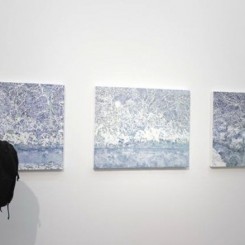“Night Light”: solo exhibition by Yu Xuhong
55 Gallery (Bldg. 4A-112, 50 Moganshan Road, Shanghai 200060, China) August 31–September 15, 2013
What are landscapes? To modern folks, they might be little more than the temporary backdrop for a narcissistic or posturing holiday snap. Landscapes have arguably long since been pushed to the fringes of urban life, like the cardboard cut-out landscape in a wedding photographer’s studio, like the romantic image of purple lavender basking in the Provençal sun, which temporarily occupies our wasteland within. Yet a yearning lingers in our memory, imagination and visions of modern civilization.
The solo exhibition of Yu Xuhong presents—drawn from the memory and imagination of the artist—the landscapes yearned for. “The artist drew from the scenery which surrounds his studio, situated by the West Lake in Hangzhou: bamboo forests, snow piles, reed fencing, undergrowth….” These landscapes appear far from the graceful scenery typically found on postcards, and further still from the glossy West Lake-style imitations in mass production. Yu’s West Lake ripples quietly after a day of snow drifting across the water, and heavy snow weighing down tree branches in deserted forests. In “Night Light No. 9”, during a snowy night, the deep lake seems covered in a thin layer of ice, the undergrowth at its edges tangled into a mesh like wolves’ teeth, sprouting in all directions, while the trees are layers of ashen grey and eerie shadows. In the painting, the density of brushstrokes collectively forms a single surface of white light; here, painting is used to open a window to another world.
Yu’s brushstrokes are short and multi-layered, and the composition of the paintings possess the sense of space in traditional Western oil painting, allowing the viewer’s field of vision to follow the direction of the brushstrokes all the way to the surface of white light at the base of the canvas. Yu’s White Light plays with opposing pairs: the darkness of night and the transparency of light are poetically brought together on the canvas; his paintings emerge from interlacing, mutually dependent relationships between canvas, pigment, and brush. In this ordered chaos, pigment is layered, etched, flicked together, to form quietly lambent landscapes.
Yu Xuhong can be regarded as a wholly painterly painter. His exploration of oil painting, from material and brushes to the transformative techniques of brushstrokes, all form part of the uncompromising meticulousness of his practice. The Night Light series were made by first covering the canvases in a layer of white pigment, with Yu using alternately hard and soft small brushes to quickly trace onto the wet paint, the brush tips pushing through to the base layer, which when repeated creates a build-up of pigment on the tips of the brushes. This repeated process of dabbing gradually produces a gently shimmering mesh of pigment which possesses its own distinctive sheen, like droplets between water and ice. This is why these paintings, when viewed from different angles, appear with different cadences of light.
The most magical state of art is to construct an imaginary reality. As the historian Simon Schama declares in his book Landscape and Memory: “Landscapes are culture before they are nature, constructs of the imagination projected on to wood and water and rock.”


